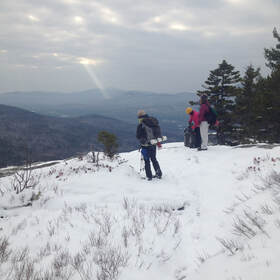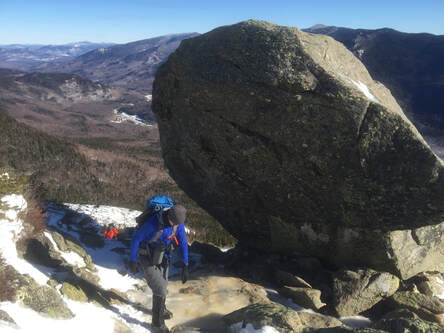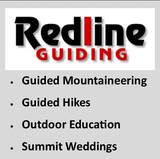|
If you are thinking of hiking high ground during spring but have limited experience doing so, this article is for you.
spring is the only season where one might experience the entire range of conditions during a single hike-- sheer ice, hard snow, deep soft snow, bare ground and ledge, and uncompromising mud. Hiking safely in this season requires careful planning and forethought. Spring season hiking can be divided into two sub-seasons: “Mud-season” (running from the end of March through Memorial Day) and “late spring” (Memorial Day through mid-June) where conditions start resembling what most people think of as spring. This is a generalization, of course—latitude, elevation, aspect (whether one is on the sunny vs the cooler side of the mountain) as well as the local winter snow load (which varies year-to-year and place-to-place) will really determine where in this spring continuum one stands. Mud Season is particularly problematic— hiking during this season has a disproportionately damaging impact to trails (see my article on Mud Season hiking). It was once the case (circa 25 years ago) that spring season hiking in the high peaks was the province of skiers trying to grab a few final runs before melt-off, and a few diehard masochistic hikers who didn't know when to quit. These days, amidst the popularity of hiking lists fueled by social media, and standing squarely in the heyday of light traction devices (Microspikes, et.al), spring hiking has become much more accessible and desirable. This inevitably means that someone who isn’t ready for the mercurial nature of spring conditions in the high peaks might end up having an uncomfortable, embarrassing, or hurtful experience. People do die with avoidable frequency in the mountains during the spring—hypothermia, frostbite, slips on ice, falling ice, and avalanches are just as cruel in the spring as they are in winter. Based on a skimming of questions in various hiking forums, here is a Q&A to help those just starting out with spring hiking in the high peaks understand what they are getting into:
Q: Which mountains in the Northeast are known to have difficult spring hiking conditions? A: Just about any mountain can be more challenging during the time between full winter snow cover and melt-off. The higher the peak, the longer winter-ish conditions will persist into the spring season. Look for particularly challenging conditions in the Adirondacks, Green Mountains, White Mountains, the highlands of northern Maine (from Grafton Notch northeast to Katahdin), and (to a lesser extent) the Catskills. Peaks above 3,000 feet anywhere in the northeast, and even lower elevation peaks in the higher latitudes should likewise be treated with the same respect through May. Q: What kind of weather should I expect in the high peaks during spring? A: Anything goes in the spring in the high peaks. You could have a full-on blizzard with fierce winds, hypothermia-inducing freezing rain, or sunny “beach weather.” Night-time temperatures may plunge significantly. Before you go, check weather reports frequently for changing summit conditions (not base conditions) and take your forecast with sobriety. Q: What kind of trail conditions should I expect in the high peaks during spring? A: Again, just about anything goes. If there was a recent spring blizzard, you could have deep unbroken snow in higher elevations. The norm tends to be a lot of ice, patches of bare ground and ledge, deep pockets and fields of drift snow (deeper and more persistent in shady areas and north slopes), and lots of mud. Snow consistency can range from concrete in the morning and evening to mashed-potatoes by mid-day. If your trail has wet brook crossings (no bridge), expect anything from wet feet to drowning torrents (drowning deaths in spring flows in the mountains aren’t rare enough). Avalanche and crushing ice-fall conditions may persist in the steeper open ravines, cirques, and on slides (as late as early July on Mount Washington). You can check trip reports at trailsnh.com to get a better sense of ground conditions, but you should carefully scrutinize trail-guide descriptions and maps as well. Q: What kind of gear should I bring for a high peaks trip in the spring? A: Plan on taking your full winter gear unless you have a recent trip report and a good weather forecast that suggests leaving something behind (for instance, a well broken out trail may not necessitate snowshoes). Always carry traction; consider full crampons for ice. Bring all of your winter clothing and safety gear but be prepared to dress down to base layers on a warm day. The cardinal rule is: when in any doubt, bring all of the gear. Q: I don’t have winter gear (snowshoes, traction, insulated boots, winter layers). Are there any high peaks I can safely do in the spring? A: It depends. On many high peaks you might not have full melt out until June, sometimes later. That said, you may be successful and safe hiking one of the smaller of the high peaks with south-facing approaches later in the spring if conditions are favorable. Again, check trip and weather reports. Lack of evidence should make you assume that the worst conditions prevail! Q: I am just starting out hiking the high peaks of the northeast. Is spring a good time to start? A: It can be the most discouraging time to start. To the extent that your inexperience could get you hurt or color your first big hike in an unpleasant light, shoot for summer or early fall. Until then, it may be wise to either hike with an experienced 4-season high peaks hiker who can show you the ropes, or consider smaller mountains (it is no secret some of us “big peak hikers” actually prefer to hike smaller mountains in the spring because conditions there are more enjoyable). Q: What about camping in the spring in the high peaks? A: Unless you are camping at low elevations, assume you’re camping in winter conditions and bring the appropriate gear (including a winter sleep system—don’t skimp on sleeping bag and sleeping pad thickness). If you haven’t camped before, spring (and winter) are difficult seasons to become accustomed to it. Q: Are there other things I need to be concerned about when hiking the high peaks in the spring? A: Yes. At lower elevations, black flies start emerging in May and can be pestilential enough to make a person want to jump off a cliff--bring bug repellant. Lack of leaf cover in early spring and light reflecting off snow can mean unrelenting sunlight on your corpse-pale winterized skin-- bring sunscreen, sunglasses, and a good hat with a visor. Black bears emerging from hibernation in the spring are ravenous from fasting all winter. If you are camping plan to secure your food in a bear cannister or with a bear proof hang bag system (cannisters are specifically required in parts of the Adirondacks). Don’t leave packs and food unattended. Happy Spring Hiking! --Paul-William *I realize this term is often applied to a certain part of the Adirondacks; I use it more generally in this case.
1 Comment
Lynn kessler
3/23/2021 09:02:32 pm
The answers to the last question had me laughing! the “ pestilential” black flies! and “corpse white skin”!😀🤣
Reply
Leave a Reply. |
TOPICS
All
Humor (The Parsnip)

|
Proudly powered by Weebly


 RSS Feed
RSS Feed
